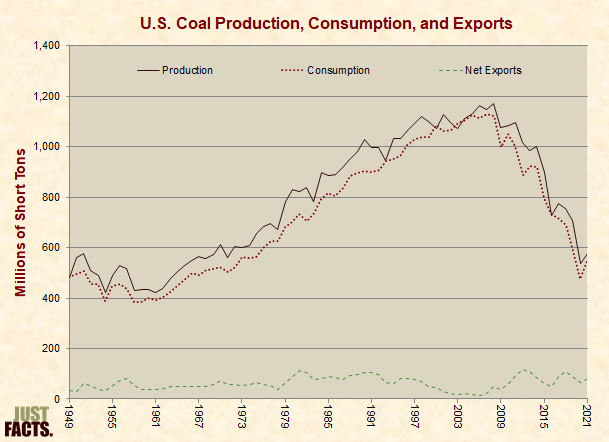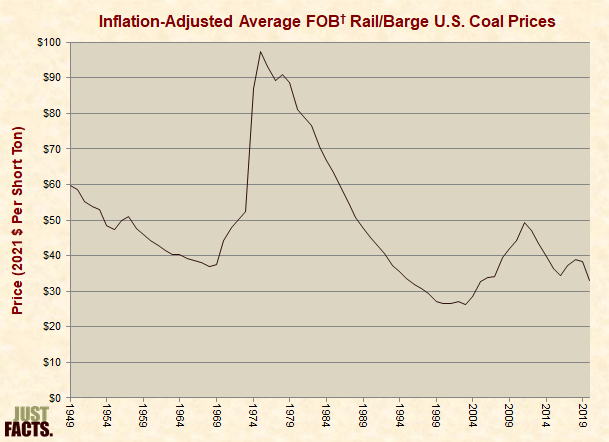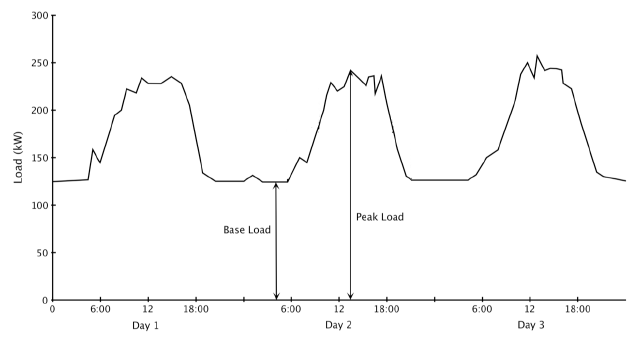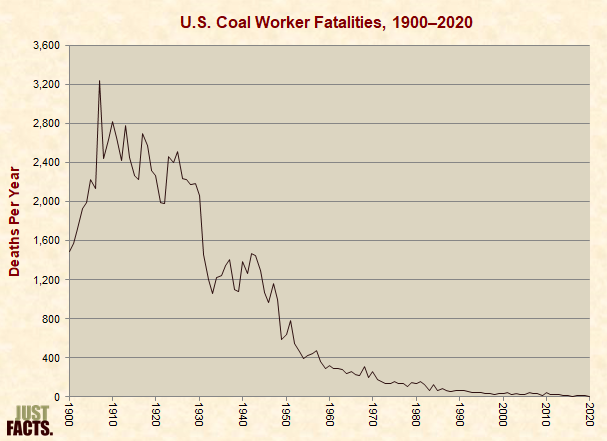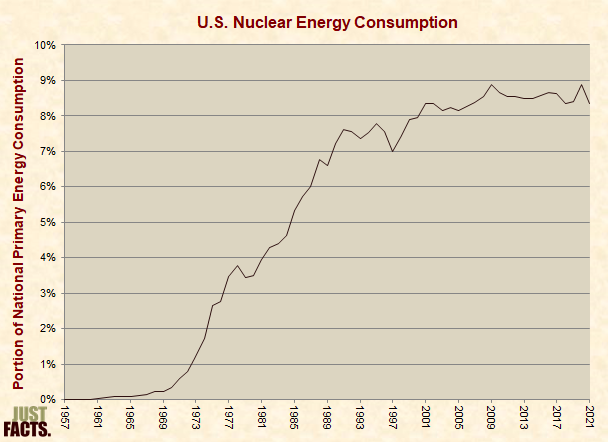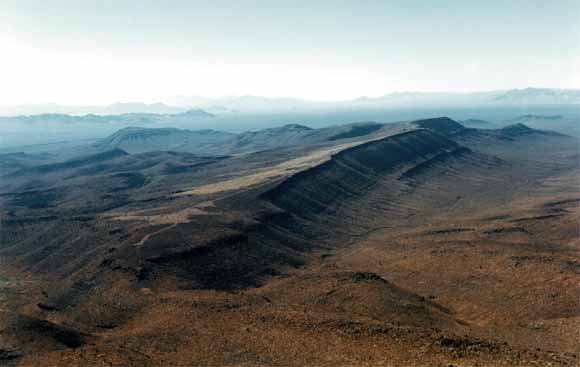Coal discussion continued from last time ………
Consumption, Production, Exports, and Prices
 * In 2015, the U.S. produced 895 million short tons of coal, consumed 802 million short tons, and had net exports of 63 million short tons.[534] [535]
* In 2015, the U.S. produced 895 million short tons of coal, consumed 802 million short tons, and had net exports of 63 million short tons.[534] [535]
* Between 2008 and 2015, U.S. coal consumption declined by 28%, primarily as a result of lower natural gas prices and stricter environmental regulations:[536] [537] [538] [539]
[540]
* In 2014, the average domestic price of coal was $35.72 per ton.[541]
[542] [543]
* Demand for electricity varies on an hourly, daily, and seasonal basis due to factors such as:
- the time of the day, which influences the usage of lighting, computers, and other electric devices.
- the weather, which influences the usage of heating, air conditioning, and ventilation systems.[544] [545] [546]
* As shown in the following graph, the terms “baseload” and “peak load” are used to describe the minimum and maximum demands for electricity over a given time period. The term “intermediate load” is used to describe the range between them.[547] [548]
[549]
* Coal is the dominant energy source for generating baseload capacity because once built, low fuel costs make coal plants inexpensive to run continuously, which is ideal for generating baseload capacity.[550] [551] [552]
* Natural gas is the dominant energy source for generating intermediate and peak load capacity because:
- natural gas power plants can ramp up and down quickly, which is ideal for intermediate and peak load capacity.
- natural gas power plants are less expensive to build than coal and nuclear power plants.[553] [554] [555] [556]
In 2009, natural gas became competitive with coal for generating baseload capacity in some areas of the U.S. This was primarily due to increased domestic natural gas production, which reduced prices. Other factors included increased coal prices, stricter environmental regulations, and expansion of natural gas pipelines.[557] [558] [559][560]
* In 2012, both coal and natural gas fuels were competitive for generating baseload capacity under differing circumstances in different regions of the U.S.[561]
* Due to their higher efficiency, natural gas power plants that employ a technology called “combined cycle” can generate baseload power less expensively than coal plants when natural gas is about 1.5 times the price of coal.[562][563] [564] In 2015, the average energy-equivalent price paid by electric power plants for natural gas was about 1.5 times the price of coal.[565]
Mining
* In the U.S., coal is mined in two primary ways: surface mining and underground mining. Per the U.S. Department of Energy:
Surface mining accounts for about 60 percent of the coal produced in the United States. It is used mostly in the West where huge coal deposits lie near the surface and can be up to 100 feet thick.
In surface mining, bulldozers clear and level the mining area. Topsoil is removed and stored for later use in the land reclamation process. Specially designed machines … expose the coal bed. Smaller shovels load the coal into large trucks that remove the coal from the pit.
Before mining begins, coal companies must post bonds for each acre of land to be mined to assure that it will be properly reclaimed. In the reclamation process … the area restored as nearly as possible to its original contours. Since 1977, more than 2 million acres of coal mine lands have been reclaimed in this manner.
Where coal seams are too deep or the land is too hilly for surface mining, coal miners must go underground to extract the coal. Most underground mining takes place east of the Mississippi, especially in the Appalachian mountain states and is used to produce about 30 percent of U.S. coal today.[566]
* In 2014, 16 U.S. coal workers were killed while working.[567] [568] In conjunction with technological advances, improved safety measures, and stricter regulations,[569] [570] coal worker fatalities have declined from a high of 3,242 people in 1907 to a low of 16 people in 2014:
[571]
* Per the Encyclopædia Britannica:
Coal mines and coal-preparation plants caused much environmental damage in the past. Surface areas exposed during mining, as well as coal and rock waste (which were often dumped indiscriminately), weathered rapidly, producing abundant sediment and soluble chemical products such as sulfuric acid and iron sulfates. Nearby streams became clogged with sediment, iron oxides stained rocks, and “acid mine drainage” caused marked reductions in the numbers of plants and animals living in the vicinity. Potentially toxic elements, leached from the exposed coal and adjacent rocks, were released into the environment. Since the 1970s, however, stricter laws have significantly reduced the environmental damage caused by coal mining.[572]
Natural Resources
* The U.S. has more recoverable coal reserves than any other nation, amounting to one quarter of the world’s coal resources.[573] [574]
* Based on U.S. Energy Information Administration (EIA) estimates from 2011, the U.S. has roughly 262 billion short tons of recoverable coal reserves, comprised of 23 billion tons of lignite, 96 billion tons of subbituminous coal, 139 billion tons of bituminous coal, and 4 billion tons of anthracite. These resources amount to:
Nuclear
* Uranium is the primary fuel used in nuclear power plants because the process of fission is most easily achieved with elements with heavy nuclei, and uranium is the “heaviest naturally-occurring element available in large quantities.”[580] [581]
* The world’s first controlled nuclear fission reactor was built in the U.S. by Italian physicist Enrico Fermi, and it became operational in 1942.[582] The world’s first nuclear-powered electricity plant was built in the Soviet Union, and it became operational in 1954.[583]
* Through fission, a single pound of uranium can generate as much energy as burning three million pounds of coal.[584]
* In 2015, nuclear energy supplied 8.5% of all primary energy consumed in the United States:
[585]
* In 2015, nuclear energy generated 19.5% of all electricity produced in the U.S.[586]
Baseload Power
* Demand for electricity varies on an hourly, daily, and seasonal basis due to factors such as:
-
the time of the day, which influences the usage of lighting, computers, and other electric devices.
-
the weather, which influences the usage of heating, air conditioning, and ventilation systems.[587] [588] [589]
* As shown in the following graph, the terms “baseload” and “peak load” are used to describe the minimum and maximum demands for electricity over a given time period. The term “intermediate load” is used to describe the range between them.[590] [591]
[592]
* Nuclear power is a major source of baseload capacity because once built, low fuel costs make nuclear plants inexpensive to run continuously, which is ideal for generating baseload capacity.[593] [594] [595]
Waste
* Because the products of nuclear fission emit hazardous levels of radiation, generate heat, and could be used in weapons called “dirty bombs,” they must be reprocessed and/or stored in secure locations and cooled.[596] [597][598] [599] [600] [601]
* Waste and fuel from commercial nuclear power plants cannot accidentally or intentionally be used to produce a nuclear blast. Such explosions require different grades of materials than those used and produced by commercial power plants.[602] [603]
* Nuclear power plant operators must pay up-front fees to the federal government for the future costs of decommissioning of their plants, thus making it impossible for operators to avoid these costs through bankruptcy after the plant closes.[604] [605] [606]
* The Nuclear Waste Policy Act of 1982 required the federal government to:
- take responsibility for storing waste from nuclear power plants and find at least one suitable location to store it.
- collect fees from nuclear power plant operators for storing the waste.
- start accepting waste from the power plants by 1998.[607] [608] [609] [610] [611]
* A 1987 law directed the federal government to evaluate storing the waste in the Yucca Mountain, which is located on a 230-square mile plot of federal land in the Mojave Desert of southern Nevada:[612] [613]
[614]
* Current law limits the amount of fuel that could be stored at Yucca Mountain to 70,000 metric tons, which is about equal to the nation’s current nuclear waste. Per evaluations performed by the Department of Energy, at least 3-4 times this amount can be safely stored at Yucca.[615] [616]
* At a cost of hundreds of millions of dollars during the 1990s, the U.S. Department of Energy drilled a 5-mile long, 25-feet diameter tunnel into the Yucca Mountain, along with a 2-mile long tunnel that branches off of it.[617] [618][619]
* A 2002 federal law approved the Yucca site for permanent nuclear waste storage.[620] [621]
* By 2006, Minnesota had banned the construction of new nuclear power plants, and 11 other states had restricted the construction of new plants until certain provisions for long-term disposal of nuclear waste are met.[622] [623] [624]
* In June 2008, the Bush administration Department of Energy (DOE) submitted an application to the Nuclear Regulatory Commission (NRC) for approval to construct a waste repository at Yucca Mountain.[625]
* In March 2009, the Obama administration DOE announced that it was going to terminate the Yucca Mountain repository. Inquiries to DOE by the U.S. Government Accountability Office and Nuclear Regulatory Commission found that the decision “was made for policy reasons, not technical or safety reasons.” Per the Obama administration DOE:
[The Energy] Secretary’s judgment is not that Yucca Mountain is unsafe or that there are flaws in the license application, but rather that it is not a workable option and that alternatives will better serve the public interest.[626][627]
* After this announcement, the Obama administration moved to shut down the Yucca Mountain program by September 2010 by terminating leases and contracts, archiving documents, eliminating the jobs of all federal employees working on the project, and disposing or transferring federal assets used for the project. [628]
* Between 1983 and 2011, the federal government spent roughly $15 billion “to evaluate potential nuclear waste repository sites, evaluate the Yucca Mountain site in more depth, and develop and submit the license application for it.”[629]
* Between 1983 and 2011, nuclear power plant operators paid more than $30 billion in fees (including earned interest) to the federal government to dispose of nuclear waste. The government used $9.5 billion of these fees “to evaluate potential nuclear waste repository sites, evaluate the Yucca Mountain site in more depth, and develop and submit the license application for it.”[630] [631]
* At the end 2014, the U.S. had more than 74,000 metric tons of commercial nuclear waste, most of which is being stored at nuclear power plants.[632] [633] [634] [635]
* Due to a breach of federal government’s responsibility to start taking waste from power plants starting in 1998, the federal government has paid $5.3 billion in court-ordered damages and settlements to power plant operators as of September 2015.[636] [637]
* In 2015, the Inspector General of the Department of Energy estimated that the federal government’s total liabilities for breaching this responsibility will amount to $29 billion. The nuclear power industry estimates that it will be at least $50 billion.[638]
* In 2013, a three-judge panel of the District of Columbia Court of Appeals ruled (2-1) that the NRC “was violating federal law by declining to further process the license application” for the Yucca facility. The court ordered the NRC to continue this process.[639] [640]
* After this ruling, the NRC published reports in 2014 and 2016 finding that the Yucca facility could safely store nuclear waste for a million years.[641] [642] [643]
 Email this author
Email this author
- The Most Progressive Budget in Virginia’s History - December 21, 2019
- When is a Clean Water Act Permit Needed? - December 21, 2019
- Should U.S. Consider Modern Monetary Theory to Improve Economy? - December 21, 2019

